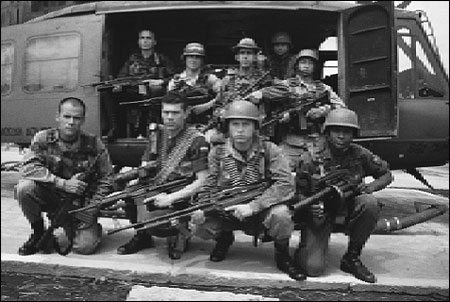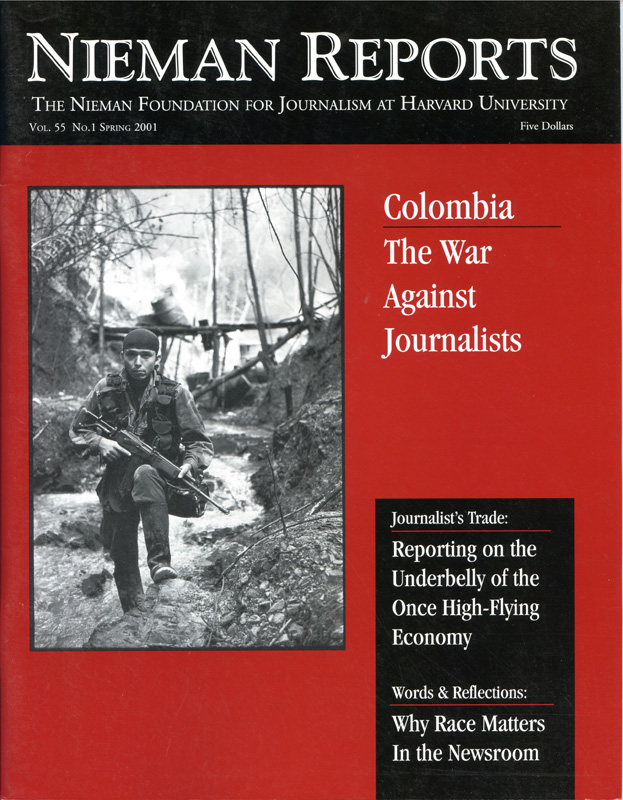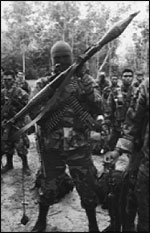
Colombia National Police “Jungle Command” anti-narcotics police troops are among the best-armed government special units in Colombia. Photo by Steve Salisbury.©
What Fernando Cano liked most about his new situation was the driving class offered to people like him who were being “protected.” Among the full array of suggestions, which included exile that the government advised, he opted for “soft security,” which meant using a strategy of keeping a low profile. Along with his brother Juan Guillermo, he had taken the helm at El Espectador weeks after his father, Guillermo Cano Izasa, had been assassinated just outside of the newspaper’s offices on the evening of December 16, 1986. Driving at high speed, he was accompanied by an expert riding on a motorcycle and well trained in the use of his MP-7 machine gun. These were the most intense moments in the action film that had become his daily life.
Three months later, the 100-year anniversary of Colombia’s oldest newspaper was observed with a special edition of El Espectador that their father had organized. At this time, the actions of drug trafficker Pablo Escobar and his Medellín cartel were destroying a peace process. One by one, more than 3,000 activists of the Unión Patriótica, whose objective was to convince the guerrillas that they could pursue their demands without weapons, were assassinated. In the midst of this dirty war, which displayed the worst practices of the cold war, President Ronald Reagan declared drug trafficking to be an American security threat. In response to Washington, the drug trafficking networks in Colombia plunged the nation into a period of “narcoterrorism.” Bombs went off at a shopping center on the eve of Mother’s Day. Airplanes blew up in mid-air. Entire city blocks were demolished.
These were the news stories that were reported every day. And El Espectador also became part of this story. Violence was directed at members of the press, in general, but also the history of our newspaper crossed paths with the history of the news. Two days before Guillermo Cano’s death, Amparo Hurtado, the Miami correspondent, had died mysteriously while reporting on the assassination of Adler “Barry” Seal, a person whose name was later mentioned in the Iran/contra scandal. Issues of the newspaper were intercepted, and the lives of national correspondents were threatened: Three El Espectador correspondents were assassinated from 1986 to 1988.
Thousands of messages conveying solidarity with our newspaper were received. These were well-intentioned and expressed the sentiment of a country that saw its mainstay, freedom of the press, growing weak. The news pages remained full, but not the newspaper’s advertising space. Advertisers received death threats, and death was foretold for those who hawked the paper on the streets. The sales manager and administrative director of the newspaper’s office in Medellín, the country’s second-largest city, and some readers and vendors were shot. The sculpture dedicated to Guillermo Cano was bombed three times. Shortly after discovering that Cano’s assassination had been paid for through secret accounts held by Pablo Escobar at the Bank of Credit and Commerce International (BCCI) (before that famous international scandal broke out), the general counsel for El Espectador, who was also a columnist, was assassinated.
By September 1989, three years later, many columnists had gone into exile, and many fellow journalists considered working at El Espectador “like having your gravestone tied around your neck.” Fernando and Juan Guillermo Cano had succeeded in slowing the pace of the losses and were preparing to expand the number of pages by purchasing additional printing apparatus. But a bomb partially destroyed the physical plant, and only one machine was serviceable, so the newspaper came out in four-page editions.
One of the stories I reported, which was published shortly before this bomb went off, spoke of activities in Colombia of Yair Gal Klein. Klein was purported to have been the mastermind behind the elimination of the perpetrators of Black September during the Munich olympics in 1972. And Peter Stuart McAleese was one of the founders of the Union for the Total Independence of Angola (UNITA). Just days after the Cold War ended, these “dogs of war” were finding new homes.
Every day at the newspaper there were reports of threatening phone calls describing imminent and future attacks. Three or four times a year we had to evacuate the building due to a bomb scare. A large part of daily conversation revolved around protection. For several months, the newest trend in clothing was the bulletproof vest designed for women. Security measures made the newspaper staff act like a team. Protective resources were shared. We would take turns sharing bulletproof vests and calls would be made from house to house to be sure friends made it home safely.
The death of Pablo Escobar in 1992 meant a reduction in the physical threats to reporters, but not of the economic risk for the newspaper. El Espectador was among the first news organizations to denounce the dirty money that President Ernesto Samper (1994-1998) received, as well as many corrupt acts by his predecessor, César Gaviria. In 1996, the newspaper’s finances burst. When the salvage plan failed, the Grupo Santodomingo, one of Colombia’s most powerful financial groups, assumed total control of the newspaper in 1998. Juan Guillermo and Fernando pulled out of the business at the same time their cousins and uncles sold their shares.
Many sensationalist stories were published about Colombia at this time. But there were also very good international journalists working in Colombia who called into question the role their own countries were playing in Colombia and in the “drug problem.” The death, kidnapping, or exile of many of my journalistic colleagues became front-page news, perhaps only because these events illuminated the disaster of a Latin American democracy engaged in an escalating war over drugs during the initial post-cold war period.
The Colombian government was incapable of guaranteeing its citizens—including its journalists—safety. This was, in part, because the threat came from a large global force—the illegal drug market—but also because other global and illegal businesses, whose principal shareholders have always been outside Colombia, also have a hand in it. These include arms traffickers as well as the illegal trafficking of persons, contraband in household appliances, chemical products and cigarettes, and the “dogs of war.” In Colombia, this is what was meant by globalization.
Among many cynical remarks I’ve heard about violence in Colombia, one stands out for me. McAleese, a soldier of fortune in Zimbabwe, South Africa, Angola and Nicaragua, and former British Special Air Services non-commissioned officer, said the following: “We were not training drug cartels’ hit squads, as various frenetic journalists later accused us of doing. With 15,000 murders every year, these Colombians did not need our help…it is the most ludicrous arrogance…to think they need outsiders to tell them how to kill each other.” This quote comes out of his 1993 book of adventures (“No Mean Soldier: The story of the ultimate professional soldier in the SAS and other forces.”) In 1989, the year McAleese referred to, the World Health Organization defined Colombia as the country with the leading incidence of violent deaths in the world, excluding motor vehicle accidents and suicide. (Since then, the figure has grown exponentially; in 1999, there were 36,650 violent deaths.) Even though McAleese’s facts were correct, it was hardly a sufficient answer to the questions the Colombian government asked when it sought his extradition, a request that the British government has never officially answered.
Israel brought charges against McAleese’s colleague Klein for selling equipment (Galil assault rifles and Uzi submachine guns) and military knowledge without government permission, but he was given a sentence without imprisonment. Klein’s students, McAleese and his 12 colleagues, had told the Colombian justice authorities that they learned attack techniques, the use of explosives, and military planning from them. It was easy for the Israeli courts to ignore the Colombian evidence; it had been prepared by a justice system in which 95 percent of cases remain in impunity. Yet in 1999, when Yair Klein was discovered smuggling machetes and helicopters in Sierra Leone, it was clear that if the Israeli courts had not made that mistake, perhaps tens of thousands of Africans would still have their hands.
During the past two decades, hundreds of journalists have been threatened, kidnapped, attacked and murdered for the work they’ve done in exposing corruption and injustice. For global opinion about Colombia to change, the nation’s courts need to clear up many cases that involve such violence. Journalists will have a large role to play in not allowing cases that have remained in impunity to be forgotten. And when the war ends, it is likely that an international court will have to be established in Colombia, similar to those dealing with Rwanda and Bosnia. But one problem is that channels do not exist for other countries to address their responsibility for what their citizens and/or businessmen do outside of their borders. For example, in October 1998, because of a joint investigation of El Espectador and The Guardian, the British House of Commons promised it would investigate for whom the British Petroleum (today BP-Amoco) adviser, in charge of security in a Colombia oil pipeline construction project, was getting military equipment and training. That investigation—just like the investigation by the German Bundestag into the activities of German spy Werner Mauss—seems to have ended up archived as a state secret. Not even those who initiated the debate have brought it up again.
There are also unsatisfactory investigations taking place in the United States. One involves coincidences in time, place and purpose between a team of 12 Pentagon trainers and the Colombian Army officers who are accused of planning and organizing—for a paramilitary group—the decapitation of 37 people (including three children) in Mapiripán, Colombia, in July 1997. These students of Klein and McAleese, known as the paramilitary forces, wanted to assume control of the coca paste market, which the guerrillas controlled. To this end, they used army equipment and installations donated by the United States. When the issue was discussed in Washington, one of the most heated debates regarding the approval of Plan Colombia ensued. Yet eventually the plan was approved, increasing 20-fold the number of U.S. military trainers in Colombia.
“Obviously our people do not teach torture. They do not teach massacres. They teach human rights in every single class…. As to the massacre, or alleged massacre and its proximity to or juxtaposition to the training activity, that is something that we will have to look at very carefully,” Assistant Secretary of Defense for Special Operations Brian Sheridan told the House Appropriations Subcommittee on Foreign Operations, in response to questions put to him by Rep. Jesse Jackson, Jr., regarding my investigation that was published in El Espectador.
Perhaps it was a mere coincidence, like other cases in which the trainers and equipment from U.S. military aid end up juxtaposed with the groups of paramilitary fighters, who are responsible for a vast majority of the human rights violations in Colombia. But global (not just United States) public opinion has the right to know just how hard a look at this matter the Pentagon takes, what conclusion is reached, and what guarantees are put in place to ensure that this or other circumstances do not give rise to more violence.
Perhaps there will be more Pulitzer Prizes and other journalism awards won by those who strike up the best friendships (and therefore are able to get the best interviews) with the guerrillas, paramilitaries, or other types of drug traffickers. Yet these journalists can make a difference not by publishing what the leaders of the various armed groups want to say, but rather what they, and their supposed enemies, want to hide.
Ignacio G. Gómez, a 2001 Nieman Fellow, is a journalist with El Espectador. He is living in exile in the United States, having fled Colombia following death threats related to his investigative reporting.




